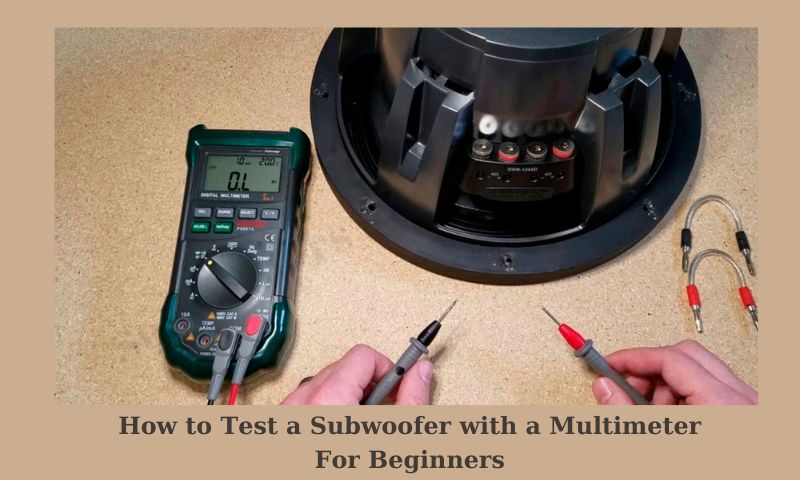Have you ever asked yourself How to Test a Subwoofer with a Multimeter? Your subwoofer’s vibrations gradually decrease or go away. In my experience, after years of heavy use, practically everyone begins to make a buzzing sound. Fortunately, it’s simple to remedy, and you can check if something is amiss by searching inside for approximately ten seconds with either hand before removing any items that might be hidden beneath the carpets where they shouldn’t be.
You may test your subwoofer with a reasonably priced and portable multimeter. Before taking any measurements, ensure all of the pieces are connected properly because the device’s ability to measure resistance is crucial for it to function properly. This blog post will go through how to use a multimeter to test a subwoofer.
Remove your subwoofer from its housing before testing it. For this job, you’ll need a small-to-medium-sized star screwdriver. It’s ideal if you can locate one with an insulated handle so your hands don’t get too hot while using it—no one wants their hands to burn while listening to speakers, right?
Fleetwood Mac songs on vinyl record player giblets should be connected to the positive (black) probe of each end. Then, increase the multimeter’s ohm setting until readings begin to indicate zero resistance across any wires as well as terminals under examination. Finally, make sure each terminal has been tested before putting all that back together.
Subwoofers are an expensive purchase, so it’s crucial to get the correct one for your vehicle. Before we test them, though, let subwoofersreview.com take you step by step through this procedure.
How to Test a Subwoofer with a Multimeter

Using a multimeter is among the simplest ways to determine whether your subwoofer box has died. You can check to see if it’s in good functioning order and how much resistance there would be at either end, either close to where sound waves enter space or on the voice coil’s side. The actions of How to Test a Subwoofer are listed below.
Step 1: Cut out the Subwoofer
You must unplug or turn off your subwoofer’s power source to take precise measurements.
Step 2: Untangle every cord
Take off your subwoofer’s screws. Please free it up by disconnecting all of its power and input wires.
Step 3: Take the Subwoofer Out of the Housing
Remember that it is not sufficient to replace simply the speakers as well as the subwoofer the next time your car’s audio system has to be upgraded. Additionally, you must be cautious when accessing this part and take off any covers before beginning.
Step 4: Getting to the Voice Coil of the Subwoofer
You can begin checking for sagging with your multimeter attached to the voice coil terminals. This examination could serve as an early warning sign that the component needs to be replaced if it detects any shorts or noises emanating from the inside.
Step 5: Attaching the Probe to the Multimeter
Ensure that the voice coil of your gadget is connected to the positive probe of the multimeter.
Step 6: Connect the Probe to the Multimeter
Then, connect the negative probe of your multimeter to this device’s most significant metal component.
Step 7: Switching on the multimeter
Next, switch your multimeter to the Ohms preset and turn it on. This will enable you to calculate the subwoofer’s resistance for correct design purposes. But after all, you might need to know How To Break In A Subwoofer?
Possible Results
- The multimeter reading reveals absolutely no resistance or reaction. This could indicate that the voice coil in your vehicle subwoofer is damaged and has to be replaced for optimum performance or that your car subwoofer has blown, which results in a loss of bass sound quality.
- The reading on the multimeter is rising steadily. This indicates that the voice coil in your device has reached its breaking point and may have suffered damage from overheating or exposure, which could later result in other issues like an open circuit in specific circumstances.
- Your coils are secure and in excellent state because the multimeter value is higher than 1.0 ohm! This could indicate another issue or that you have not connected everything completely.
Conclusion
Understanding How to Test a Subwoofer with a Multimeter will help you avoid spending money on unnecessary repairs when you want to be sure it is in good operating condition. If any issues are discovered during this brief check, they must be fixed right away, thus knowing the knowledge can help you prevent expensive downtime.
I advise hiring an expert rather than trying to repair or fix things around your home. If you try to handle this on your own, you’ll wind up spending more money in the long run because they can locate and fix what requires to be fixed right away while saving everyone involved time.

